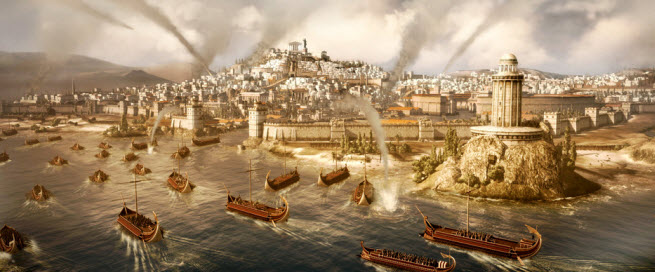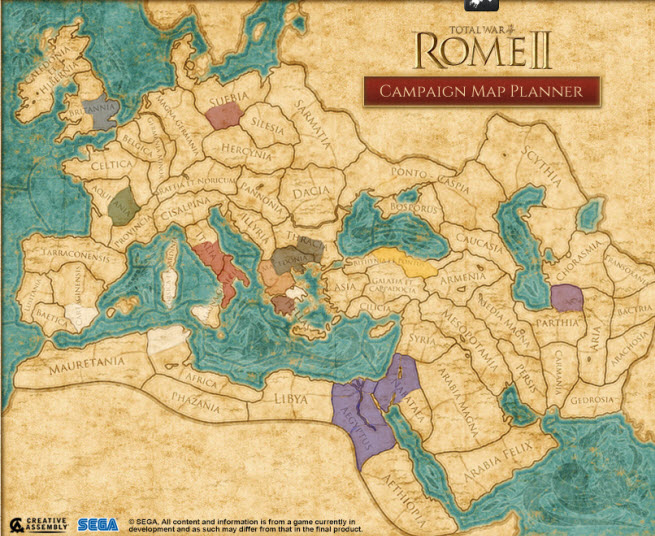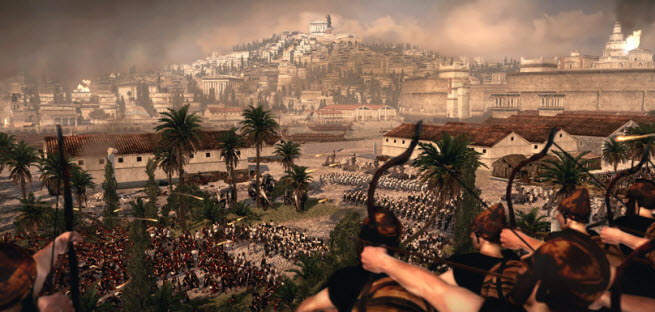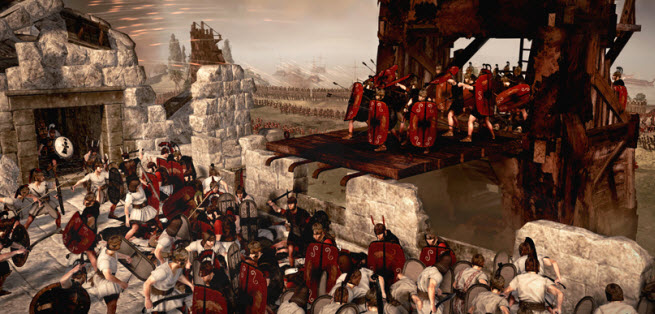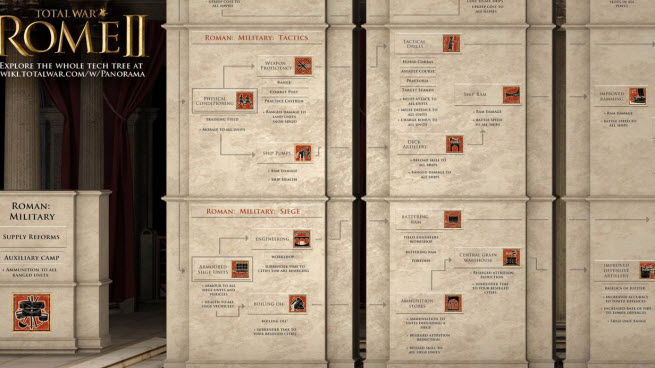PC game fans are eagerly awaiting today’s release of Total War: Rome II, the latest in the Total War real-time strategy series from Sega’s Creative Assembly. Those players will deal with the same immediate question once they start playing: Which lands should you conquer first?
Rome II will return you to epic clashes of empires across stunning panoramic landscapes, only bigger and better than its predecessor, Rome: Total War, which came out nine years ago. During that time, Creative Assembly has honed its graphics skills and found a better interface for managing a far-flung empire.
Like the first Rome game, which sold very well, this title has the potential to break into the mainstream if only to bring out the conqueror in all of us. Hopefully, it will promote world peace. After all, now that I’ve played, I no longer feel the need to pillage my neighbor’s house or the rest of the world. Crossing the Alps? Been there; done that.
In this combination of Civilization-style military strategy and real-time combat akin to Age of Empires, you begin as a humble tribe in control of a single province of Italy. Your aim is to build the Roman empire, city by city, region by region, from Britannia to the edge of India. A short tutorial shows how the Romans took on the hill tribe of the Samnites. At the beginning of the single-player campaign, in the year 272 B.C., just about any region can become an empire. The Romans must conquer the Etruscan League, their foes to the north. After that, you the player are free to venture anywhere though sometimes you launch campaigns at the behest of the Senate. If there is a crowning accomplishment to Rome II, it’s this. It feels like an open world, an infinitely replayable space where you can choose the course to greatness or ruin.
You can expand further north into the lands of the Veneti or drive south to Syracuse and Carthage. The enemies may come at you from all sides, or even from within, through political intrigue and civil war before you finish building your war machine. You can win via cultural or economic victories in addition to conquest, but you have no real choice. Your empire has to expand or die. If you fight everyone at once, you’ll lose. I found this the hard way as I started and then restarted my empire several times. You should feel free to start and stop as well because you’ll be stuck with those early choices for a long time.
You can actually skip the tactical battles if you are infatuated with the strategic game. You can automatically resolve a battle, sort of like a coin toss weighted with all sorts of modifiers. But then you would be missing the best part, and the game would be a poor stepchild compared to Civilization.
The battles are what this game is about. In them, you move your soldiers in cohort-size formations, attacking and countering the enemy as their commander does the same thing. Once the armies lock arms in battle, only one of them comes out standing from the brawling mass that resembles two beehives in combat.
If you played every battle, the game would be longer. But it’s also more fun. I’ve played the single-player campaign for 23 hours now, and I’ve only consolidated control over Italy, Sardinia, Corsica, Syracuse, and Carthage. I have enlisted the Ligurians in the north and the Syracusans in the south as my allies, extending my power through them. But there is so much more territory for me to explore and conquer, not counting the historical single-player battles, multiplayer online combat, and the Greek States day-one expansion pack.
What you’ll like
A simpler interface and easy learning process
Rome II is very educational, and parents will be tempted to use it as a learning tool, but there’s no hiding the fact that it is a very deep and detailed strategy game. Hardcore players love this kind of stuff, but controlling what happens in the real-time battles takes practice. If you’re familiar with the user interface of the past games, this one isn’t that different. The beautiful, strategic map is layered upon the individual tactical battlefields. When you hover over a region, you see its vital statistics such as its size, happiness, and security levels.
The gameplay is familiar to past fans. You maneuver your armies on the turn-based campaign map, and when two armies meet, the game zooms in on a 3D battlefield where they clash in real time. In this action, you can zoom out to see the full strategic picture from a bird’s-eye view or zoom in on an individual cohort as it engages in a pitched tactical battle. The cinematic, movie-like view on the ground is very well done, with the sounds and screams of combat integrated with the animated 3D graphics of the soldiers. Those battles look good, and they can tell you exactly how your troops are faring, but the cinematic view isn’t necessary to running the battle.
You start out with a short tutorial campaign against the Samnites. This campaign shows you the complexity of the world, including the military gameplay, the economic decisions, and the political battles. The campaign at the first battle at Capua is meant to give you a hang of the 3D controls. You can maneuver through the battlefield with the WASD keys on your keyboard, and you can rotate the map with the Q or E keys. That gives you control over the 3D view. You can group your soldiers into battle groups, change their formations, and line them up one next to the other so they can all give each other morale boosts. But once you set them loose into battle, it’s up to them to win.
The most common way to fight is to pin down the enemy with your infantry, such as your swordsmen. You can take out a lot of soldiers with archers. But the cavalry is best for maneuvering around the enemy and then hitting them on the flanks, resulting in massive kills. Once you launch a good flank attack, the odds are good that the defenders will collapse and run. And once you get some enemies on the run, the rest will likely follow. If you learn that much, you’ll be able to take out enemy armies that are larger than your own.
Another new tactical element that helps you fight is “true line-of-sight.” This means that you and the enemy can only see forces arrayed on the battlefield if they are within the line of sight of one of your own units. If you hide some troops in the trees, they can come out during the battle and ambush the enemy.
Once you take over a city, you’ll find that it is connected to as many as three others in a province. To control the province, you’ll have to take over the walled capital city. That means you can either besiege the city and starve out the inhabitants. Or you can build siege weapons and storm it by force. The good thing is that you don’t have to spend time building the actual siege weapons. You simply select them during the siege and wait until they are finished. Then you’ll have either sheltered battering rams or siege towers to assault the ramparts. Once you fight a battle, you can immediately save it for replays if you wish.
A vast empire to conquer and defend
The huge variety of strategic options is one of the joys of Rome II, which is the most ambitious game yet from Sega’s Creative Assembly. I’ve only scratched the surface of it. There are 10,000 unique battlefields available across the map, including battles that take place in the sea or in major rivers like the Nile. The huge map ensures that you’ll never run out of random or strategic places to meet the enemy. But the map of Europe, North Africa, and Near Asia is designed with a lot of strategic choke points such as roads through forests or river crossings where you can set up ambushes or forts. You can fight in these locations or do battle in great walled cities, commerce ports, or barbarian villages. The title features more than 700 different unique tactical units, from war elephants to slingshot troops.
There are nine playable factions at the start, including Rome, Carthage, Ptolemaic Egypt, Macedon, Pontus, Parthia, the Suebi, the Averni, and the Iceni. I played the Romans, of course, but I gained an appreciation for the different kinds of units that I fought against. The Carthaginians led their armies with archers mounted atop elephants. Those elephants could be dangerous if you allow them to charge. But I took them out with my own onslaught of arrows. The bad thing about elephants is that they wreak havoc among your own troops once they start getting wounded and then panic. They run around wildly and cause a lot of disruption in the ranks.
Each faction is part of a different cultural group: Roman, Hellenic, Eastern, and Barbarian. Each faction also has its own historical missions, its own geographical starting position, its own tech trees, famous generals, agent variants, units, traits, and benefits. The Eastern factions are great traders while the Barbarians have high morale in battle. Roman provincial capitals can be hubs for complex military organizations while the Greeks have strong cultures.
Better management layers
If there is a flaw in Total War games, it’s that they try to cram too many games into one game. Do we really need a complicated spy game on top of the empire-building game? Not really.
Compared to past games, the designers of Rome II have imposed some limitations to address the problem of complexity. No longer do you have tiny armies roaming the map without great leaders. Each province — two to four cities — can field no more than three armies or fleets, each led by a noble general. This limitation means that you’ll concentrate your forces in large armies and fight huge battles, not tiny skirmishes. The number of spies is also limited.
The map interface is also well conceived. You can easily see where you stand relative to another faction through a diplomacy menu or just by hovering over the faction’s region on the strategic map. That’s a smart way to communicate information to the player.
From an economic view, the player manages a province as a whole, not a region, and you only build certain kinds of specialized buildings. (By contrast, in the Civilization series, you can micromanage the construction of dozens of building types). Public order is maintained on a provincial level. That means you have to keep all of the cities in the region happy or they will rebel. If you own all of the regions in a province, you can gain economic advantages and issue edicts that bring benefits such as extra food. The management layers are a welcome relief because they reduce the complexity without sacrificing depth or gameplay. You can still do things such as engage in spy-versus-spy assassinations; you just can’t do it in every city on the map.
When your empire grows sizable, you’ll run into a variety of challenges, like how to spend money on one province but not on another or how to deal with growing corruption.
Smarter A.I., but not too tough to beat
The compliment I can pay to Creative Assembly is that the artificial intelligence (A.I.) of the computer-controlled players seemed both smart and dumb, reflecting the behavior of a real human player.
The apparent stupidity of the A.I. shows during the sieges. When the enemy attacked me in the walled city of Carthage, it had no siege weapons. So it marched a few companies of spearmen up to the walls. I rained down arrows on them, but they managed to set the gates on fire. Rather than storm the gates, the A.I. pulled back to the edges of the map. Instead of waiting for the clock to run down, I chose to sally forth and started attacking some of the A.I. groups piecemeal. They were all spread out, so I took a large force and routed them one by one. Finally, however, the A.I. did the smart thing. It got between me and the city gates and then rushed them with a large force. I had to chase it down and had only left a weak force guarding the burning gates. So the A.I. forced its way in. But rather than charge for the victory points, it started taking possession of city wall towers. I fought my way back inside and then took the A.I. forces down. It was perhaps the silliest battle in all of history, but I won.
Yet there were also some pitched battles where I could swear I was fighting against a human. Syracuse was a single city-state that seemed like an easy target, but it proved to be the bane of my empire.
Syracuse had a large navy and an army, too. I approached it with several different fleets. But instead of waiting for me to attack, the AI launched an attack on me. It attacked a small fleet and then lured in my reinforcements and took out two fleets in a naval battle where it outnumbered me. It took me awhile to build up another invading force. The next time, I attacked with a large force that I landed on the shores, so I avoided the naval battle. Then I marched my soldiers inland and set up a naval blockade around the city. I consolidated my army and reinforcements and set up a land siege around the city. I took it by storm.
But I didn’t notice that an army had slipped off into the woods. After all, Syracuse’s navy was sailing all around the ocean. After I sailed my army away toward Carthage, the rebel army came out of hiding and attacked my occupied Syracuse. It outnumbered my forces by two to one. It assaulted, and I was able to hold off the larger forces in the narrow streets of the town. But my troops grew weary, and the battle whittled down my force to just a few soldiers. My general got killed, and then my forces melted away. I lost by just a few soldiers, and as a result, I lost the entire city and control of the province. That put a big stumbling block in my road to empire.
Still, I loved having a computer opponent that, for once, gave me a real test and taught me a lesson. There were many such moments in pitched tactical battles where the fortunes swayed back and forth — where one side that seemed to be winning suddenly lost the upper hand and ultimately the battle. It is moments like those that help you appreciate the enormity of historical battles and the heroes that succeeded or failed in winning them.
Trained units add depth to your decisions
After you’ve fought some battles, you’ll see why it pays to have trained generals in charge of trained troops. Your general levels up by gaining skills that give him better leadership abilities in sea or land combat. With a better general and troops that have seen battle, the chances are greater that a cohort will hold its ground in a one-on-one battle against another unit. A wavering line of troops can get spooked easily, and veterans can last longer than green troops. Moreover, flank attacks are more effective now as the combat system allows for multiple attacks against one soldier rather than one-on-one combat. And since veterans can execute flank attacks better, their assaults can have a more devastating impact on an entire wing of an army.
The presence of trained troops will make you think more about the order of battle. You’ll want to have strong units at the critical center and flanks. The only trouble is that the game can play out over centuries, so your generals will have a limited life span. They will either die in battle, particularly if you expose them to frontline combat, or die of old age. (They can also be assassinated by spies, who have their own rankings and promotions.) But units such as famous legions can last forever. They do so by carrying on a name and their traditions for certain kinds of combat behaviors. Those traditions can be passed along for generations. If an army is destroyed, you can restore its banner and its traditions with new troops.
On the political side, you want to keep the balance of power among the different noble houses by appointing generals from each house to positions of power. Your own influence is determined by the “Gravitas” ratings of your household characters. You can gain and lose influence through actions such as marriage and assassination. You can incite a civil war if you want to become the emperor.
I found that this leadership growth among generals and units, along with the political intrigue among various factions of Rome, very intriguing.
Outstanding 3D graphics
Within the real-time battles, you can zoom in on individual soldiers fighting and pull up to a board-game style view from above. But most of your practical battle management will take place at an angled 3D view, just above your forces. You can zoom in and out with the mouse wheel, and the game responds in a fluid fashion. You can get about 2,000 soldiers on the battlefield in a single formation. That doesn’t seem like much, but it is a good choice by Creative Assembly because it’s harder to control a huge army. But you can still get more of your own soldiers into a fray by positioning several armies together. Once you attack with one, the others will show up as reinforcements who run onto the battlefield in real time against you. I had one battle with more than 5,000 soldiers fighting on my side, and you can get more than that if you like.
But the terrain plays a big factor as well. Like the armies, the landscapes are all beautifully animated. You can fight in dense forests, deserts, or detailed cities. The provincial capitals have their own walls, towers, gates, temples, monuments, squares, and quays. The combat takes place along broad avenues that can become bottlenecks that are defended by a single unit, if necessary. Rain or fog can completely change the nature of the battle as soldiers can bog down and become tired in a torrent or lose sight of the enemy entirely in dense fog. The visual weather changes are top-notch, too.
What you won’t like
The human face animations aren’t perfect
I’ve already mentioned that the enemies can be really dumb on occasion. But there are a few other flaws.
Rome II’s great promise was that it would show you combat from the individual soldier to the giant bird’s-eye view of the army. But the animated faces in the cutscenes — done within the Rome II engine — fall a little short of the best that we’ve seen in gaming.
As with most video games, the human faces are far from perfect when it comes to animation quality. In the cutscenes, the lip sync isn’t always a match, and the facial expressions of the characters are somewhat limited. The cinematics often catch the individual views of a pack of soldiers attacking each other in one big mass of limbs and bodies. You have to look for a while to figure out any useful information, like which side is winning a melee.
I have to say that this isn’t quite like watching a movie like Braveheart yet and feeling like you are inside the movie, on the battlefield. That day will come, but the facial animations are the barrier that the developers must conquer one of these days.
The occasional bugs
The game crashed on me once, but I didn’t lose anything. I simply rebooted and continued from the place where I left off. The saving system seemed to work fine for me. Others have noticed small glitches like a spy walking across the water rather than sailing in a boat or slow framerates during a three-way multiplayer battle. But I actually didn’t encounter major problems in the single-player campaign. The greater frustrations come from the performance.
The slow sweep of turns
Rome II is a lot like the Civ games, especially late in a campaign, where it seems to take forever to execute and finish the turns.
After you end your turn, every faction has to make its move. And because many of these turns could be relevant to you, Rome II tries to graphically show you what many of the visible factions are doing. This is a necessary but wasteful part of the game. It seems like Creative Assembly should figure out a way to process those moves in the background while you’re still able to do something within the game.
I played the title on a fairly hefty PC (the Toshiba Qosmio X875 with an Intel Core i7-3610QM running at 2.3 gigahertz with 16 gigabytes of RAM and 64-bit Windows 7 Home Premium), but the turns still ran slow. When you’re cruising across the landscapes, you’ll notice that the performance slows on occasion. But for the most part, the game ran fine in real-time battles, where it counts most.
An economy that won’t keep up with your ambitions
Sometimes there’s a mismatch in your willingness to wage war and your ability to fight it. Your ability to recruit soldiers depends on how well you manage the economy. And it’s hard to tell exactly how much you should be investing in it versus your military might. When your economy goes into the dumps, it’s hard to turn it around.
Your citizens starve, and they revolt. Then your expansion grinds to a halt, and you fall behind your rivals in acquiring new territory. Rome II just doesn’t give you enough warnings about how to govern your empire in a balanced way. As a result, you have to go through a trial-and-error process. You tweak your economy little by little, and you build your armies little by little — even though you would rather move faster. The tech tree, pictured above, also seems a little clunky and doesn’t convey as much information as it should.
That could be avoided if the economic indicators were there to give you that warning or if Creative Assembly did a better job of explaining the game’s economics to you. I would really appreciate it if it had more Civilization-style leaderboards to show me at a glance the factions that matter instead of just a list of all of the factions. In fact, I would be happy if the game told me, “Sorry, you have absolutely no hope of winning this game right now, and you really should start over.” That might save me 30 hours of trying to revive a dying empire or republic.
Conclusion
By far, the positives outweigh the negatives in this ambitious game. I’m glad that Creative Assembly shot so high with its design, and I’m hoping that some of the performance glitches will be improved with patches.
I think that hardcore gamers — including any fans of the Total War, Civilization, and Age of Empires games — will love this title. It’s a little heavy on the violence (particularly in the victory cinematics, where one army vanquishes another), but there isn’t much actual bloodshed. It’s also a little complex for younger students, so don’t expect this to be a great history-teaching tool for elementary schoolchildren. In that respect, the teen rating is quite appropriate.
I’ve played many games in this series, including Shogun: Total War and Total War: Rome, and I have been amazed each time by the improvements in gameplay and graphics. This title is the most impressive yet, and I can easily see someone sinking in hundreds of hours — without running into constant reruns of gameplay or visuals.
For those who want more action, you can immediately buy the downloadable content, the Greek States Culture Pack, which includes Epirus, Athens, and Sparta. The potential for expansion is mind-boggling, and it reminds me of the expansions for the Age of Empires games, which also taught history. Give Rome II a try. When it comes to combining strategy and tactics, all roads lead to Creative Assembly.
Score: 90/100
Total War: Rome II was released on Sept. 15 on the PC. The publisher provided GamesBeat with a download code for the purpose of this review.
The title won’t run on just any PC. It is playable on Windows XP, Windows Vista, Windows 7, and Windows 8. It requires a PC with a minimum 2-gigahertz Intel dual-core processor or a 2.6 Ghz single-core Intel processor; 2 gigabytes of RAM; a 512 megabytes graphics card with Direct X 9.0c compatibility, 35 gigabytes of hard disk space, and a screen resolution of 1024 x 768. The recommended spec is for Windows 7 or Windows 8; second-generation Intel Core i5 processor or better; 4 gigabytes of RAM; a 1024 megabyte graphics card with DirectX 11 compatibility; 35 gigabytes of hard disk space; and a screen resolution of 1920 x 1080.
VentureBeat's mission is to be a digital town square for technical decision-makers to gain knowledge about transformative enterprise technology and transact. Learn More
